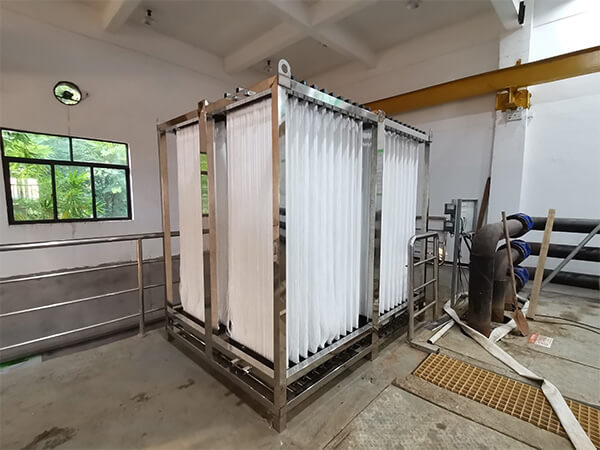Advantages of Membrane Bioreactors
A membrane bioreactor (MBR) is an advanced wastewater treatment system that combines membrane separation technology with biological treatment processes. It primarily includes three types: membrane separation (MBR), membrane extraction (EMBR), and membrane aeration (MABR). Membrane separation MBRs are the most widely used in domestic projects, while the other two types are still in the experimental or small-scale application stages.
I. Overview of Technical Features
MBR technology is a modified form of activated sludge systems. Unlike traditional processes that separate sludge and water in sedimentation tanks, MBRs use membrane modules to directly separate solids and liquids. This method traps activated sludge within the bioreactor, increasing the microbial concentration and degradation rate within the reactor, while ensuring more stable and clear effluent quality.
Based on operating conditions, MBRs are categorized as aerobic or anaerobic. Their core membrane components can be categorized by material, such as organic or inorganic membranes, and by structural form, such as hollow fiber membranes, plate membranes, and tubular membranes. Furthermore, they can be installed in two ways: submerged (or internal) or external (or split).
II. Main Advantages of Membrane Bioreactors

The membrane components possess extremely high separation precision, effectively isolating suspended solids, colloids, and pathogenic microorganisms from water. The suspended solids concentration and turbidity of the effluent are virtually zero, far exceeding the separation efficiency of traditional secondary clarifiers.
Flexible and Stable Operation Control
The membrane’s high retention capacity allows microorganisms to be completely retained within the reactor system, enabling fully independent control of the hydraulic retention time (HRT) and sludge retention time (SRT), improving the system’s shock resistance and operational stability.
Enhanced Nitrogen and Phosphorus Removal
The system facilitates the retention and growth of microorganisms with long reproduction cycles, such as nitrifying bacteria, enhancing nitrification efficiency. By optimizing operating methods, nitrogen and phosphorus removal targets can also be effectively achieved.
Improving the treatment capacity of difficult-to-degrade substances
Due to the long sludge age, the limited reactor volume provides ample reaction time for large, difficult-to-degrade pollutants, significantly improving their degradation rate.
Low sludge production and no bulking issues
Operating at a low sludge load, the amount of residual sludge is significantly lower than with traditional processes. Sludge bulking is also eliminated, simplifying the sludge treatment process and reducing disposal costs. Because the membrane provides stable and reliable separation, water quality is no longer affected by sludge settling properties, completely eliminating the sludge bulking problem common in activated sludge processes.
Easy to operate and easily automated
MBR systems are suitable for automated operation, facilitating remote monitoring and intelligent management, and offering simple and efficient operation and maintenance.
Small footprint and high system integration
Due to the high microbial concentration maintained within the biological reactor, high reaction efficiency, and compact equipment, without the need for traditional sedimentation units, the overall footprint is significantly smaller than conventional processes, making it particularly suitable for areas with limited land.
Summary
By combining the separation advantages of membrane technology with the efficient degradation capabilities of biological processes, membrane bioreactors not only significantly improve effluent quality and treatment efficiency, but also offer numerous advantages, such as low sludge production, ease of operation, and a compact system. They have become an important technology choice in modern wastewater treatment.
